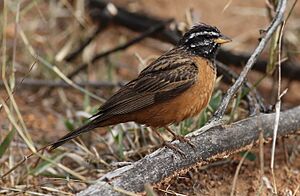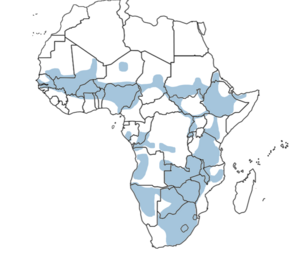Cinnamon-breasted bunting facts for kids
Quick facts for kids Cinnamon-breasted bunting |
|
|---|---|
 |
|
| At Pilanesberg National Park | |
| Conservation status | |
| Scientific classification | |
| Genus: |
Emberiza
|
| Species: |
tahapisi
|
 |
|
| Distribution of cinnamon-breasted bunting |
|
| Synonyms | |
|
Fringillaria tahapisi |
|
The cinnamon-breasted bunting (scientific name: Emberiza tahapisi) is a small bird. It is also called the cinnamon-breasted rock-bunting. This bird lives in many parts of Africa, south of the Sahara Desert. It is known for its pretty colors and unique songs.
Contents
About the Cinnamon-breasted Bunting
Naming and History
Scientists first officially described the cinnamon-breasted bunting in 1836. A Scottish zoologist named Andrew Smith gave it the scientific name Emberiza tahapisi. He found the first birds near the Vaal River in South Africa.
The name tahapisi comes from the Tswana language. "Thagapitse" is a Tswana word for different types of finches, which are small birds.
This bird is a type of passerine, which means it's a perching bird. It belongs to a group of birds called "buntings." There are a few different kinds, or subspecies, of the cinnamon-breasted bunting. Scientists sometimes debate if some of these are separate species or not.
What Does It Look Like?
Cinnamon-breasted buntings are small birds. They usually weigh between 11.6 and 21 grams. They are about 13 to 15 centimeters long.
You can spot them by their striped heads and cinnamon-brown chests.
- Males have clear black and white stripes on their heads. Their throat patch is solid black.
- Females have browner, less dark stripes. Their throat patch is smaller and grayish with spots.
- Young birds (juveniles) look like females. But their head stripes are a bit lighter and browner.
After the breeding season, adult birds grow new feathers. Young birds also get some new feathers.
Their Songs
Cinnamon-breasted buntings sing short, high-pitched, and fast songs. Males can have many different songs. Each song has unique sounds.
Their songs often end with a special whistle sound. Birds sing from high places. They like to sit on trees, bushes, or rocks to sing.
Where They Live and Their Home
Habitat and Range
These buntings live in many places across sub-Saharan Africa. They avoid very dry deserts and thick forests. They also don't live in very high mountains.
They prefer rocky hillsides. These areas usually have thin woods and bare ground. Sometimes, you can find them in more wooded areas too.
Some groups of these birds move around. They might fly north during the rainy season. Then they go south when it's dry. They also move to lower places in winter.
How They Live
Breeding and Nests
The breeding season for these birds changes. It depends on when the rainy season is in their area. In dry places, they breed during the whole rainy season. In places with more rain, they breed at the end of it.
They usually have one partner for breeding (monogamous). They build their nests alone. The nest is made of twigs and grass. They often place it on the ground in a shady spot.
Both the male and female birds take care of the eggs. They also feed the young birds. Eggs hatch in about 12 to 14 days. The young birds leave the nest after 14 to 16 days. But they stay near their parents for about three more weeks. A female usually lays 2 to 4 eggs. The eggs are greenish or bluish-white. They have dark brown or reddish-brown spots.
What They Eat
Cinnamon-breasted buntings mostly eat seeds. They find their food on the ground. They also eat insects, especially when they are in captivity. Sometimes, they jump to pull seeds from plants. Parents feed both seeds and insects to their chicks.

Social Life and Behavior
You often see these birds alone or in pairs. They can also gather in small groups of 3 or 4 birds. Sometimes, you might see groups of 6 to 8. When they migrate, they can form larger groups of up to 40 birds.
A common behavior for buntings is tail flicking. They do this while hopping on the ground. It helps them get noticed by other birds.
When they want to find a mate, males chase females in the air. Males might also bring nesting materials to the nest. Females may shiver their wings and make a special "eep" sound.
If they feel threatened, they might freeze and watch. They might also fly away or make alarm calls. If the danger is big, they might "mob" the threat. This means a group of birds will attack or annoy a predator.
Cinnamon-breasted Bunting and People
Sometimes, these birds fly into towns. In some countries, people catch them to keep as pet birds. They usually do well in captivity.
Status and Protection
The IUCN (International Union for Conservation of Nature) says these birds are of "Least Concern". This means they are not currently in danger of disappearing. In fact, their living areas have grown since 1985. This is partly due to climate change and changes in their habitat.


